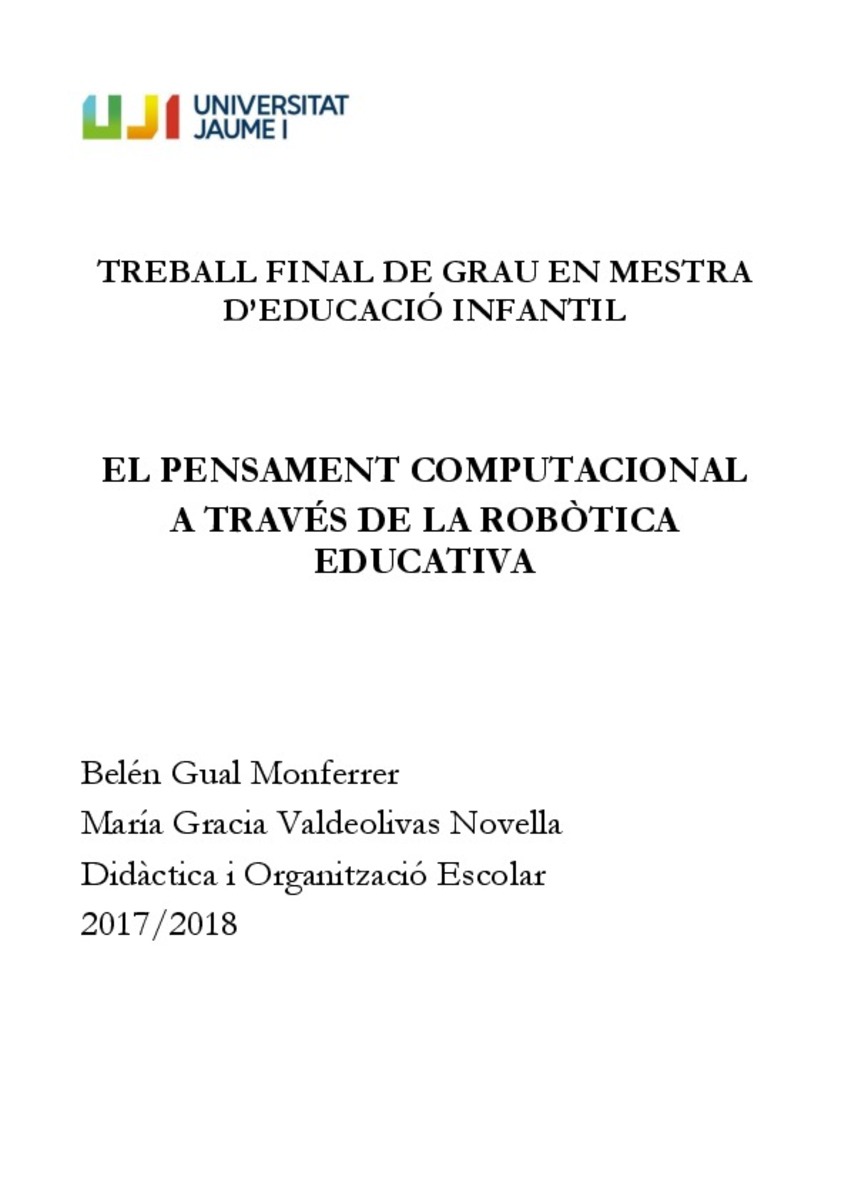Mostrar el registro sencillo del ítem
El pensament computacional a través de la robòtica educativa
| dc.contributor.author | Gual Monferrer, Belén | |
| dc.contributor.other | Valdeolivas Novella, María Gracia | |
| dc.contributor.other | Universitat Jaume I. Departament de Pedagogia i Didàctica de les Ciències Socials, la Llengua i la Literatura | |
| dc.date.accessioned | 2018-12-18T08:30:43Z | |
| dc.date.available | 2018-12-18T08:30:43Z | |
| dc.date.issued | 2018 | |
| dc.identifier.uri | http://hdl.handle.net/10234/178204 | |
| dc.description | Treball Final de Grau en Mestre o Mestra d'Educació Infantil. Codi: MI1040. Curs acadèmic: 2017/2018 | ca_CA |
| dc.description.abstract | L’educació és l’eina fonamental per a canviar el món i tots som capaços d’aprendre si ens ho proposem i tenim motivació per fer-ho, independentment de l’edat i dels coneixements previs adquirits. És per aquest motiu que, com a docents, hem d’intentar lluitar per avançar i aprendre en la nostra professió, perquè ser docents en aquesta societat canviant ens fa estar actualitzats i en formació constant. Actualment, és molt important incorporar les TICs als centres docents com una nova eina a l’aula, ja que tenen un valor imprescindible i un impacte molt positiu en les generacions presents i futures d’aquesta era digital. Així doncs, la competència digital, incorporada en el Decret 38/2008, és una part necessària en l’educació actual i ha d’estar sempre present, perquè té una rellevància per a tot ciutadà que viu en societat. I és per això que es vol arribar a les TACs, utilitzant ferramentes tecnològiques per a futurs aprenentatges. Durant l’estada en pràctiques s’ha dut a terme una investigació per poder investigar si els infants del segon cicle d’infantil, més concretament els de 5 anys, són o no capaços d’exercitar el pensament computacional a través de la robòtica educativa. I per poder comprovar-ho, se’ls ha proposat als alumnes un repte robòtic que comprén 7 nivells diferents i en el qual l’eina fonamental és el llenguatge de programació, materialitzat a través del robot Bee-Bot. Per poder dur a terme el repte robòtic, hi ha hagut un treball d’esforç i constància per part de l’alumnat al llarg de les setmanes. Durant aquest temps s’ha treballat amb diferents materials sobre distintes àrees curriculars, però sempre amb l’objectiu principal de treballar el pensament computacional a través de la robòtica educativa. Seran capaços tots els alumnes de superar el repte robòtic proposat? Aprendran a treballar el llenguatge de programació? | ca_CA |
| dc.description.abstract | Education is the fundamental tool for changing the world and we are all capable and motivated to learn if we set out to do so, regardless of age and previous knowledge acquired. It is for this reason that, as teachers, we have to try to fight to advance and learn in our profession, because being teachers in this changing society means that we are updated and in constant training. Nowadays, it is very important to incorporate ICTs in schools as a new tool in the classroom, since they have an essential value and a very positive impact on present and future generations of this digital age. Thus, digital competence, incorporated in Decree 38/2008, is a necessary part of today's education and must always be present, because it is relevant for all citizens living in society. And that is why we want to reach ACTs, using technological tools for future learning. During the internship, research has been carried out to investigate whether or not children in the second cycle of infancy, more specifically those aged 5, are capable of exercising computational thinking through educational robotics. And to prove it, the students have been offered a robotic challenge that includes 7 different levels and in which the fundamental tool is the programming language, materialized through the Bee-Bot robot. In order to carry out the robotic challenge, there has been a lot of hard work and perseverance on the part of the students over the weeks. During this time, we have worked with different materials on different curricular areas, but always with the main objective of working on computational thinking through educational robotics. Will all students be able to overcome the proposed robotic challenge? Will they learn to work with the programming language? | ca_CA |
| dc.format.extent | 33 p. | ca_CA |
| dc.format.mimetype | application/pdf | ca_CA |
| dc.language.iso | cat | ca_CA |
| dc.publisher | Universitat Jaume I | ca_CA |
| dc.rights | Licencia CC-BY-NC-SA | ca_CA |
| dc.rights | Atribución-NoComercial-CompartirIgual 4.0 Internacional | * |
| dc.rights.uri | http://creativecommons.org/licenses/by-nc-sa/4.0/ | * |
| dc.subject | Grau en Mestre o Mestra d'Educació Infantil | ca_CA |
| dc.subject | Grado en Maestro o Maestra de Educación Infantil | ca_CA |
| dc.subject | Bachelor's Degree in Preschool Education | ca_CA |
| dc.subject | Repte robòtic | ca_CA |
| dc.subject | competència digital | ca_CA |
| dc.subject | pensament computacional | ca_CA |
| dc.subject | robòtica educativa | ca_CA |
| dc.subject | llenguatge de programació | ca_CA |
| dc.subject | Robotic challenge | ca_CA |
| dc.subject | digital competence | ca_CA |
| dc.subject | computational thinking | ca_CA |
| dc.subject | educational robotics | ca_CA |
| dc.subject | programming language | ca_CA |
| dc.title | El pensament computacional a través de la robòtica educativa | ca_CA |
| dc.type | info:eu-repo/semantics/bachelorThesis | ca_CA |
| dc.educationLevel | Estudios de Grado | ca_CA |
| dc.rights.accessRights | info:eu-repo/semantics/openAccess | ca_CA |
Ficheros en el ítem
Este ítem aparece en la(s) siguiente(s) colección(ones)
-
Grau en Mestre o Mestra d'Educació Infantil [1149]
MI1040; MI1840








